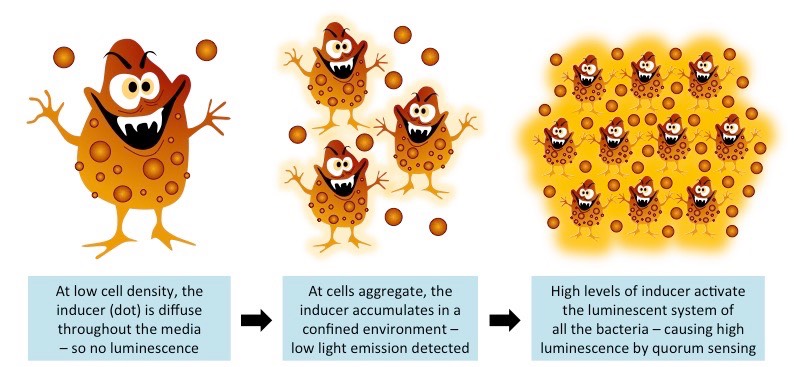![]()
Understanding:
• Cooperative aggregates of microorganisms can form biofilms
• Microorganisms in biofilms cooperate through quorum sensing
Biofilm Formation
A biofilm is a cooperative aggregate of microorganisms associated with a surface and enclosed in a polymeric matrix (‘slime’)
- Biofilms can form on solid and liquid surfaces and may be composed of a single species or many species of microorganism
Biofilm formation begins with the attachment of microorganisms to a surface through weak, reversible associations
- If not removed, the microorganisms form more permanent, irreversible attachments using adhesion structures (such as pili)
- The cells forming a monolayer will grow and divide, before producing an exopolymer matrix to enclose the developing colony
Biofilm Development

Quorum Sensing
As the biofilm develops, microorganisms will alter their gene expression in response to changes in population density
- This pattern of behaviour is called quorum sensing and is mediated by the release of chemicals from colony cells
- Individual cells release inducer chemicals that will trigger specific transcriptional changes when a threshold is surpassed
- As cells begin to aggregate, the concentration of inducer chemicals increases to exceed the required threshold
- This triggers a synchronised change in gene expression, allowing the biofilm to operate as a coordinated system
Quorum sensing allows the biofilm to grow and develop in a manner that is not uniform and promotes structural stability
- Channels will form in order to facilitate the spread and incorporation of nutrients throughout the biofilm
- Metabolic activity can create changes in the microenvironment, prompting the differential distribution of microorganisms
- For example, the establishment of an oxygen gradient will differentially localise aerobic and anaerobic metabolisers
Example of Quorum Sensing – Bioluminescence (Vibrio fischeri)

![]()
Understanding:
• Biofilms possess emergent properties
• Microorganisms growing in a biofilm are highly resistant to antimicrobial agents
Emergent Properties
Through quorum sensing, microorganisms in a biofilm possess functions beyond those that are present in an individual cell
- The cooperative action of cells in the biofilm combine to create new synergistic effects (emergent properties)
One emergent property commonly identified in biofilms is an increased resistance to antimicrobial agents
- Within a biofilm, some microorganisms develop into non-dividing, slow-growing persister cells
- These cells exist within a physiologically dormant state, which makes them insensitive to the action of antimicrobial drugs
- Consequently, these cells survive antimicrobial treatments and function as a reserve from which the biofilm can repopulate
- This renders antimicrobial drugs ineffective in the treatment of biofilms and associated diseases
![]()
Skill:
• Evaluation of data or media reports on environmental problems caused by biofilms
Environmental Problems
Biofilms are ubiquitous in nature and will form on virtually any non-shedding surface in a moist environment
- Biofilms in streams form an important component of aquatic food chains and also filter sediments to maintain water quality
- Microbial biofilms are actively involved in the decomposition of biotic debris and the recycling of nutrients
- Biofilms may form on plant surfaces to form symbiotic relationships with the plant (e.g. nitrogen-fixing Rhizobium on roots)
- Alternatively, biofilms may form on plant surfaces to cause crop diseases (e.g. citrus canker is associated with biofilms)
- Biofilms are present on the surface of animals (e.g. dental plaque on teeth) and may cause diseases when present internally
- Biofilms can form on man-made structures such as faucets and sewage pipes, resulting in long-term corrosion
- Biofilm adhesion to ship hulls serves as the foundation for biofouling on marine vessels
- Biofilms can also serve constructive purposes, including in food preparation, bioremediation and sewage treatment
Researchers Tackle Dangerous – But Poorly Understood – Biofilms
Source: National Science Foundation
